
14 Squadron RNZAF is a squadron of the Royal New Zealand Air Force. In 2015 the squadron was re-raised and equipped with 11 Beechcraft T-6 Texan II. A new aerobatic display team called the Black Falcons was also formed using the new aircraft. They replaced the RNZAF display team known as the Red Checkers.

No. 15 Squadron was a fighter squadron of the Royal New Zealand Air Force that was formed in June 1942. It served in Tonga, Guadalcanal, New Georgia, Espiritu Santo, Bougainville and Green Island. The squadron was equipped with Kittyhawk and, later, F4U Corsair fighters. The squadron was disbanded in October 1945.
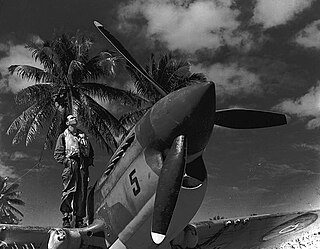
No. 16 Squadron was a fighter squadron of the Royal New Zealand Air Force. Formed in July 1942 at RNZAF Base Woodbourne, the squadron was equipped with Curtiss P-40 Kittyhawks and later F4U Corsairs. The squadron fought in the Southwest Pacific theatre during the Second World War, flying combat operations against Japanese forces. Proposed re-equipment with the P-51 Mustang was abandoned at the cessation of hostilities, and the squadron returned to New Zealand where it was disbanded in October 1945.

No. 25 Squadron of the Royal New Zealand Air Force was formed at Seagrove, Auckland in July 1943 with Douglas SBD Dauntless dive bombers and served in the Southern Pacific based at the Piva Airstrip on Bougainville, flying missions against Japanese forces on Bougainville and at Rabaul. It was disbanded in May 1944 and reformed as a fighter/ground attack squadron flying F4U Corsairs. It served in Santo, Guadalcanal, Los Negros and Emirau, before returning to New Zealand and being disbanded in September 1945. A SBD-4 Dauntless operated by 25 Squadron was for a time preserved in the Royal New Zealand Air Force Museum at Wigram, displayed in the condition which it was recovered after being lost with its crew while on a training mission at Espiritu Santo. One of the SBD-5 aircraft operated by 25 Squadron has been restored to flying condition in America for the "Planes of Fame" museum, in the colour scheme of an American aircraft.

No. 488 Squadron was the name given to two distinct Royal New Zealand Air Force squadrons during the Second World War. Both were formed under Article XV of the Empire Air Training Scheme and served under the operational command of the Royal Air Force.

No. 6 Squadron RNZAF is a maritime squadron of the Royal New Zealand Air Force. It has a history going back to World War II, when it operated flying boats, and has been disbanded and re-formed several times through changes in the country's military structure. The squadron motto, originally "Fortitudine et Diligentia", is now “Vigilance with Patience”.

No. 75 Squadron is a Royal Australian Air Force (RAAF) fighter unit based at RAAF Base Tindal in the Northern Territory. The squadron was formed in 1942 and saw extensive action in the South West Pacific theatre of World War II, operating P-40 Kittyhawks. It was disbanded in 1948, but reformed the following year and operated jet aircraft throughout the Cold War. The squadron was based at Malta from 1952 to 1954, flying de Havilland Vampires, and Malaysia from 1968 to 1983, with Dassault Mirage IIIs, before returning to Australia.
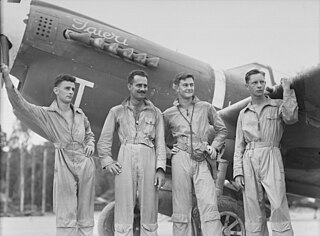
No. 17 Squadron was a fighter squadron of the Royal New Zealand Air Force. Formed in October 1942 at Ohakea, the squadron was initially equipped with Curtiss P-40 Kittyhawks, before converting to F4U-1 Corsairs in 1944. The squadron fought in the Pacific theatre during World War II, flying combat operations against Japanese forces until it was disbanded in late 1945.

John Albert Axel Gibson, was a Royal Air Force (RAF) officer and a flying ace of the Second World War. He was credited with the destruction of 12 enemy aircraft.

No. 26 Squadron RNZAF was a squadron of the Royal New Zealand Air Force. Formed in October 1943, during World War II, from "C Flight", No. 25 Squadron at RNZAF Station Seagrove to be equipped with Douglas SBD Dauntless dive bombers, however was disbanded in January 1944. Reformed in March 1945 at RNZAF Station Ardmore, equipped with Chance-Vought F4U-1 Corsair fighter bombers. The squadron was based at Kukum Field on Guadalcanal and Piva Airfield on Bougainville before being disbanded in June 1945.
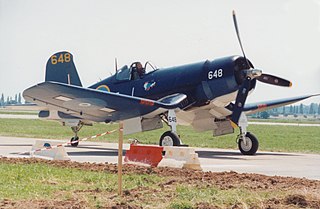
No. 22 Squadron RNZAF was a squadron of the Royal New Zealand Air Force. Formed in August 1942, during World War II, at RNZAF Station Onerahi equipped with the Hawker Hind, co-ordinating with New Zealand Army units providing training for air liaison officers. Reformed on 19 June 1944 at RNZAF Station Ardmore, equipped with Chance-Vought F4U-1 Corsair fighter bombers. The squadron served at airfields in Espiritu Santo, Guadalcanal, Bougainville and Emirau before being disbanded in September 1945.

No. 41 Squadron was a transport unit of the Royal New Zealand Air Force (RNZAF). The squadron was formed in 1944, and conducted transport flights in the south Pacific during World War II. It remained active after the war, and flew supplies to the New Zealand occupation force in Japan. Three crews from the squadron participated in the Berlin Airlift during 1948 and 1949, and one of its flights was temporarily based in Singapore from 1949 to 1951. From 1955 the entire squadron was stationed at Singapore, from where it participated in the Malayan Emergency, Indonesia–Malaysia confrontation and Vietnam War. Detachments of No. 41 Squadron were also based in Thailand from 1962 to 1965. The squadron was disbanded in 1977.
No. 20 Squadron was a squadron of the Royal New Zealand Air Force. It was first established at as an army co-operation unit, serving in this role between 1942 and 1943. In January 1944, the squadron was reformed as a fighter unit at equipped with P-40 Kittyhawks. It later flew F4U-1 Corsair fighter bombers.
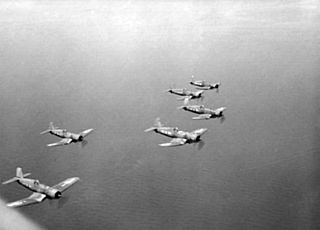
No. 18 Squadron was a squadron of the Royal New Zealand Air Force. Formed in June 1943 at RNZAF Base Woodbourne, the squadron was initially equipped with Curtiss P-40 Kittyhawks, before converting to F4U-1 Corsair fighter bombers in 1944. The squadron fought in the Pacific theatre during World War II, flying combat operations against Japanese forces until it was disbanded in late 1945.
No. 23 Squadron was a squadron of the Royal New Zealand Air Force. It was formed in August 1944 at RNZAF Station Ardmore equipped with the F4U-1 Corsair fighter bomber.
No. 21 Squadron was a squadron of the Royal New Zealand Air Force. Formed in May 1944, it was equipped with F4U-1 Corsair fighter bombers.

Michael James Herrick, was a New Zealand flying ace of the Royal Air Force (RAF) during the Second World War. He is credited with having shot down at least six enemy aircraft.
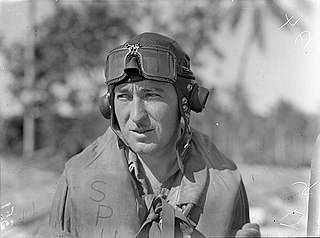
Robert Lawrence "Peter" Spurdle was a New Zealand flying ace of the Royal Air Force (RAF) during the Second World War. He was credited with the destruction of ten enemy aircraft.
No. 62 Squadron RNZAF was a radar squadron of the Royal New Zealand Air Force during the Second World War. The squadron was formed at Guadalcanal in August 1943 and comprised all the RNZAF radar units sent overseas. The Squadron was disbanded in October 1944.
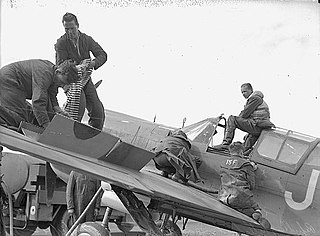
Percival Guy Haig Newton, was a flying ace of the Royal New Zealand Air Force (RNZAF) during the Second World War. He was credited with the destruction of at least five enemy aircraft.














